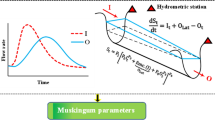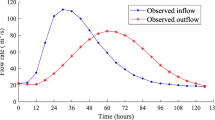Abstract
The Muskingum model is not only a simple conceptual flood routing method but is also widely used by water resources engineers. Since Muskingum model parameters cannot be determined physically, the calibration of these parameters is the only challenge of this method. Although various techniques have been recommended for this purpose, a more accurate method with faster convergence rate is still required to improve the computational precision for parameter estimation. In this study, a new model was presented based on the linear Muskingum model for more accurate flood routing. In this model, the Muskingum parameters are allowed to change in the flood period, whereas in the classical model they are forced to be fixed over the entire flood interval. The Modified Honey Bee Mating Optimization (MHBMO) algorithm was utilized for the estimation of linear Muskingum parameters. The proposed model using the MHBMO algorithm was compared with constant-parameter model calibrated with other techniques in the literature for a case study. The results demonstrate that not only can the new model reduce the sum of the square of the deviations more than 50 %, but the MHBMO algorithm can also be confidently used to estimate the parameters of the Muskingum model.


Similar content being viewed by others
References
Afshar A, Bozorg Haddad O, Marino Miguel A, Adams BJ (2007) Honey-bee mating optimization (HBMO) algorithm for optimal reservoir operation. J Franklin Inst 344(5):452–462
Afzali SH (2015) New model for determining local scour depth around piers. Arab J Sci Eng. doi:10.1007/s13369-015-1983-4
Chen J, Yang X (2007) Optimal parameter estimation for Muskingum model based on Gray-Encoded Accelerating Genetic algorithm. Commun Nonlinear Sci Numer Simul 12:849–858
Chow VT (1964) Handbook of applied hydrology. McGraw-Hill, New York
Easa SM (2012) Improved nonlinear Muskingum model with variable exponent parameter. J Hydrol Eng ASCE 18(12):1790–1794
Esmi Jahromi M, Afzali SH (2014) Application of the HBMO approach to predict the total sediment discharge. Iran J Sci Technol Trans Civ Eng 38(C1):123–135
Gill MA (1978) Flood routing by the Muskingum method. J Hydrol 36(3):353–363
Guang-Te W, Singh V (1992) Muskingum method with variable parameters for flood routing in channels. J Hydrol 134(1):57–76
Haddad OB, Afshar A, Marino MA (2006) Honey bees mating optimization (HBMO) algorithm: a new heuristic approach for water resources optimization. Water Resour Manag 20(5):661–680
Koussis A (1978) Theoretical estimations of flood routing parameters. J Hydraul Eng ASCE 104(HY1):109–115
Lamberti P, Pilati S (1988) A simplified flood routing model: variable parameter Muskingum (VPM). Meccanica 23(2):81–87
Linsley R, Kohler MA, Paulhus J (1982) Hydrology for engineers. McGraw-Hill, New York
Mays LW (2011) Water resources engineering, 2nd edn. Wiley, USA
Niazkar M, Afzali SH (2015a) Optimum design of lined channel sections. Water Resour Manag 29(6):1921–1932
Niazkar M, Afzali SH (2015b) Assessment of modified honey bee mating optimization for parameter estimation of nonlinear Muskingum models. J Hydrol Eng ASCE 20(4):04014055
Niknam T (2009) An efficient hybrid evolutionary algorithm based on PSO and HBMO algorithms for multi-objective distribution feeder reconfiguration. Energy Convers Manag 50(8):2074–2082
Niknam T, Meymand HZ, Mojarrad HD (2011) An efficient algorithm for multi-objective optimal operation management of distribution network considering fuel cell power plants. Energy 36(1):119–132
O’Donnell T, Pearson CP, Woods RA (1988) Improved fitting for three-parameter Muskingum procedure. J Hydraul Eng ASCE 114(5):516–528
Perumal M (1994) Hydrodynamic derivation of a variable parameter Muskingum method: 1. Theory and solution procedure. Hydrol Sci J 39(5):431–442
Perumal M, Raju KGR (1998) Variable-parameter stage-hydrograph routing method. II: evaluation. J Hydrol Eng ASCE 3(2):115–121
Ponce VM, Changanti PV (1994) Variable-parameter Muskingum–Cunge method revisited. J Hydrol 162(3):433–439
Ponce VM, Yevjevich V (1978) Muskingum-Cunge method with variable parameters. J Hydraul Eng ASCE 104(1):1663–1667
Qu G (1977) Parameter estimation for Muskingum models. J Hydrol 36(3):40–43
Tahershamsi A, Sheikholeslami R (2011) Optimization to identify Muskingum model parameters using Imperialist Competitive Algorithm. Int J Optim Civil Eng 3:475–484
Tang XN, Knight DW, Samuels PG (1999) Volume conservation in variable parameter Muskingum–Cunge method. J Hydraul Eng ASCE 125(6):610–620
Wang W, Xu Z, Qiu L, Xu D (2009) Hybrid chaotic genetic algorithms for optimal parameter estimation of Muskingum flood routing model. In: Computational sciences and optimization, 2009. CSO 2009. International joint conference, vol 1, pp 215–218
Wang W, Kang Y, Qiu L (2010) Optimal parameter estimation for Muskingum model using a modified particle swarm algorithm. In: 2010 third international joint conference on computational science and optimization (CSO), vol 2, pp 153–156
Wilson EM (1974) Engineering hydrology. Macmillan Education LTD, Hampshire
Yang X, Jin J, Chen Z, Wei Y (1998) A new approach for parameter estimation of Muskingum routing model. J Catastrophol 13:1–6
Yoon J, Padmanabhan G (1993) Parameter estimation of linear and nonlinear Muskingum models. J Water Resour Plan Manag ASCE 119(5):600–610
Zhan SC, Xu J (2005) Application of ant colony algorithm to parameter estimation of Muskingum Routing Model. Ziran Zaihai Xuebao/J Nat Disasters 14(5):20–24
Zhengxiang Y, Ling K (2010) Application and comparison of several intelligent algorithms on Muskingum routing model. In: Information and financial engineering (ICIFE), 2010 2nd IEEE international conference, pp 910–914
Author information
Authors and Affiliations
Corresponding author
Rights and permissions
About this article
Cite this article
Afzali, S.H. Variable-Parameter Muskingum Model. Iran. J. Sci. Technol.Trans. Civ. Eng. 40, 59–68 (2016). https://doi.org/10.1007/s40996-016-0001-8
Received:
Accepted:
Published:
Issue Date:
DOI: https://doi.org/10.1007/s40996-016-0001-8




